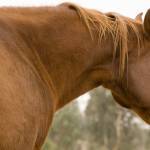Response of Quarter Horses to High Fat, Low Carb Diets

Polysaccharide storage myopathy (PSSM) is a chronic form of tying-up syndrome. This disorder is particularly prevalent in horses with Quarter Horse breeding. Signs occur in varying degrees of severity and include muscle cramping, stiffness, reluctance to move and loss of ability to stand.
Serum creatine kinase (CK) is often abnormally high in horses with PSSM. In normal muscle function, CK is an enzyme involved in creating a high-energy molecule that is burned as a rapid energy source for muscle tissues. CK is normally resident in muscle cells, and elevated CK in the bloodstream is an indication that muscle damage has occurred. Horses that suffer with PSSM or experience rhabdomyolysis show massively elevated serum CK concentration.
Excessively high insulin sensitivity and a build-up of glycogen in the muscle fibers are also characteristic of PSSM. Research suggests that PSSM-affected horses use stored glycogen for energy normally, and therefore the problem may lie in excessive production and storage of glycogen. Horses with clinical signs of PSSM have been known to benefit from diets lower in starch and higher in fat than traditional equine rations.
In this study, the research objective was to discover whether these types of diets may help not only to alleviate signs of disease in affected horses, but also to prevent the onset of PSSM in clinically normal horses. The study was designed to investigate the glycemic and insulinemic responses to such a diet in Quarter Horses that did not show signs of disease.
How was the research conducted?
Twelve Quarter Horses (8 mares, 4 geldings) were used for the study. The horses were aged 8±1.9 years with an average body condition score (BCS) of 5.0 and an average body weight of 434± 80.5 kilograms. All horses were clinically healthy and none had shown previous signs of myopathy. All had tested negative for the hyperkalemic periodic paralysis gene, the cause of a heritable condition characterized by muscle tremors, trembling and weakness.
All the horses had been regularly exercised in the months leading up to the study. During the study the horses were ridden for an hour daily at a moderate training intensity. The horses were split into four groups and fed one of four isocaloric diets in a 4X4 Latin square design. Each diet was fed at a rate of 1 kilogram twice a day (0700 and 1800 hours) for 3 weeks. The horses were housed and fed individually during this time. All horses received haylage semi ad lib as well as their treatment diets. The treatment diets were as follows:
Control (CO) – whole barley and oats
SB- sugar beet pulp, grass meal, soybean oil
RB- rice bran, grass meal
CP- rice bran, grass meal, sugar beet pulp, soybean oil
The control diet had a starch level of 53% and a fat level of 4%. The other diets had starch levels of 0 to 11% and fat levels of 13 to 15%. The horses also received 0.5 kilograms of a mineral and vitamin mix each day.
At the end of each 3-week period, the horses were fed 1 kilogram of their test diets (haylage was not fed on test days). Blood was sampled at 0, 30, 60, 90, 120, 180, 240 and 300 minutes after feeding. The blood plasma was analyzed for basal CK (at the 0 hour only) and glucose while the serum was analyzed for insulin. The area under the curve (AUC) was calculated for glucose and insulin. The AUC for the treatment diets were compared to the control diet for estimation of glycemic and insulinemic index.
What results were found?
During the study, the horses gained an average of 7 kilograms in weight and retained a BCS average of 5.0. Basal levels of serum creatine kinase were above normal. Two horses developed CK activity above 1000 mL but only on the control diet of barley and oats. This may have suggested a subclinical myopathy. The extremely high CK concentration typical of PSSM horses did not occur. Time to reach peak glucose was quickest in the CP diet (60 minutes) followed by RB and SB (both 120 minutes) and was longest in CO (180 minutes). Peak glucose concentration was highest in the CO diet, followed by the SB, RB, and CP diets respectively.
Compared with the average post-meal plasma glucose figures, basal CK was particularly high with the CO diet and particularly low with the RB and CP diets.
What does this research tell us about feeding Quarter Horses?
The research showed that diets higher in fat and lower in soluble carbohydrates produced lower glycemic and insulinemic responses to feed than is seen with more traditional equine rations. In addition, CK levels were lower in horses consuming these diets. The control diet of oats and barley produced the highest levels of glucose, insulin, and serum CK.
Low-starch and high-fat diets produce lower fluctuations in glucose, may depress insulin, and can allow some PSSM-affected horses to exercise with minimal discomfort. The horses in this study may have had subclinical myopathy indicated by their above-normal CK levels, and therefore might fall into a class of horses with the potential to be helped by non-traditional diets.
Because of the correlation between post-meal plasma glucose patterns and basal serum CK activity, the researchers suggested that feeding diets high in fat and low in starch may be helpful not only in treating horses affected by PSSM but also in preventing future episodes of PSSM in particularly susceptible horses. Rice bran, sugar beet pulp, grass meal, and soybean oil are suitable feed ingredients for inclusion in such diets.
The study, “Glycaemic and insulinaemic response of Quarter Horses to concentrates high in fat and low in soluble carbohydrates,” was conducted by A. Zeyner, C. Hoffmeister, A. Einspanier, J. Gottschalk, O. Lengwenat, and M. Illies.








